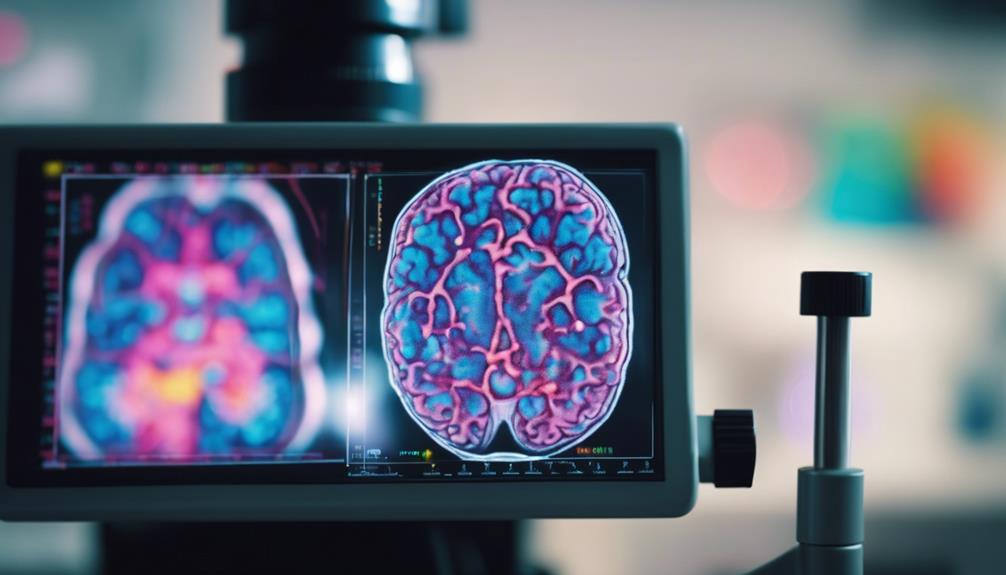Narcissistic Personality Disorder affects about 6.2% of individuals in their lifetime, with men more impacted at 7.7% versus women at 4.8%. It commonly coexists with substance use and mood disorders, making treatment intricate and integrated. Variations in demographics and cultural influences contribute to the prevalence differences seen. Diagnosing NPD can be challenging due to symptom overlaps with other disorders like Borderline Personality Disorder. Impact on individuals includes strained relationships, low self-esteem, and elevated suicide risks during rejection. Therapeutic interventions like DBT and CBT, along with tailored treatment plans, are essential. Addressing NPD thoroughly is key to effective management. Learn more about NPD complexities ahead.
Key Takeaways
- Lifetime prevalence of NPD is approximately 6.2%.
- Men have a higher prevalence (7.7%) than women (4.8%).
- NPD often coexists with other mental health disorders.
- Diagnosis requires structured evaluations due to symptom overlap.
- Tailored interventions are crucial for managing NPD's complexities.
Prevalence of Narcissistic Personality Disorder
Discussing the prevalence of Narcissistic Personality Disorder (NPD) sheds light on its impact within the general population. Research suggests that NPD affects approximately 6.2% of individuals over their lifetime. This statistic reveals the significant presence of NPD in society and underscores the importance of understanding its implications for mental health and well-being.
Moreover, NPD appears to be more prevalent in men, with a rate of 7.7% compared to 4.8% in women. These gender differences raise questions about the potential underlying factors contributing to the development of NPD within different demographic groups.
Additionally, individuals with NPD often experience comorbidities with various mental health conditions such as substance use disorders, mood disorders, anxiety disorders, and other personality disorders. This high comorbidity rate complicates both the diagnosis and treatment of NPD, emphasizing the need for thorough and integrated approaches to address the complexities associated with this disorder.
Factors Influencing NPD Prevalence

Factors that influence the prevalence of Narcissistic Personality Disorder include demographic variations, comorbidities with other mental health conditions, and gender disparities. When considering NPD prevalence, it's important to understand the interplay of these factors:
- Demographic Variations: Certain demographic groups exhibit higher rates of NPD, contributing greatly to its prevalence within the population.
- Comorbidities with Mental Health Conditions: NPD often coexists with substance use disorders, mood disorders, anxiety disorders, and other personality disorders, amplifying its commonality.
- Gender Disparities: Men tend to have a higher prevalence of NPD compared to women, with statistics showing 7.7% in men and 4.8% in women in the general population. This disparity sheds light on the gender-specific impact on NPD prevalence.
Understanding these factors is essential in comprehending the prevalence of NPD and its implications for individuals affected by this personality disorder in the United States.
NPD Across Different Populations

NPD prevalence rates vary across different populations, with men showing higher rates compared to women. Cultural influences may also play a role in the manifestation of NPD within specific demographic groups.
Understanding these variations is essential in developing tailored interventions and support systems for individuals affected by NPD.
NPD Prevalence Rates
In various demographic groups, the prevalence rates of Narcissistic Personality Disorder (NPD) exhibit notable variations. When considering NPD prevalence rates:
- General Population: The lifetime prevalence of NPD stands at 6.2%, indicating a significant presence within society.
- Gender Disparity: Men exhibit a higher prevalence of NPD at 7.7% compared to women at 4.8%, highlighting a gender-based difference in manifestation.
- Comorbidity Factors: NPD often coexists with substance use, mood disorders, anxiety disorders, and other personality disorders, emphasizing the complexity of diagnosis and treatment in individuals with multiple mental health concerns.
These variations underscore the multifaceted nature of NPD's impact across different populations, necessitating tailored approaches for diagnosis and intervention strategies.
Cultural Influences on NPD
Across diverse cultures, the prevalence of Narcissistic Personality Disorder (NPD) demonstrates important variability influenced by societal norms and values. Cultural factors play a vital role in shaping the expression and manifestation of NPD symptoms.
In collectivist cultures, where group harmony is emphasized, lower reported rates of NPD may be observed. On the other hand, individualistic cultures, which value personal achievement and success, might exhibit higher rates of NPD. Studies indicate that the cultural context greatly impacts the presentation of NPD behaviors.
Understanding these cultural influences is essential in comprehending the nuances of NPD across different populations. By recognizing how societal norms shape personality traits, we gain insight into the complex interplay between culture and mental health.
Diagnostic Challenges of NPD

Diagnosing Narcissistic Personality Disorder (NPD) can be tricky since its symptoms often overlap with Borderline Personality Disorder (BPD).
Professionals rely on structured evaluations and interviews to navigate the complexity of NPD criteria.
Coexisting conditions like depression or anxiety further complicate the diagnostic process.
Diagnostic Criteria Complexity
Mastering the intricate diagnostic criteria of Narcissistic Personality Disorder presents mental health professionals with significant challenges. When evaluating individuals for NPD, professionals encounter complexities that require thorough assessment techniques. Here are key aspects contributing to the diagnostic challenges:
- Meeting Criteria: Individuals must exhibit at least five out of nine specific criteria to receive an NPD diagnosis, necessitating a thorough evaluation process.
- Overlapping Symptoms: Symptoms of NPD may overlap with those of other personality disorders, making it important to differentiate and identify specific indicators accurately.
- Structured Assessments: Mental health professionals utilize structured interviews and assessments to systematically evaluate and diagnose NPD, ensuring precise identification for effective treatment planning and intervention strategies.
Overlapping Symptoms With BPD
Understanding the diagnostic complexities of Narcissistic Personality Disorder, especially in relation to Borderline Personality Disorder, involves identifying the shared symptoms that can pose challenges in accurate differentiation. Both disorders exhibit overlapping symptoms such as unstable self-image, impulsivity, and intense emotions, making it tricky to distinguish between them.
When diagnosing individuals with these mental health conditions, it's essential to carefully assess specific criteria related to self-importance, empathy, and relationship patterns. Since Narcissistic Personality Disorder and Borderline Personality Disorder can co-occur, clinicians must navigate through these similarities to provide effective treatment.
Evaluating manipulative behaviors and underlying motivations is key to differentiating between the two disorders accurately. Understanding the unique features of each disorder is essential for precise diagnosis and tailored interventions.
Impact of NPD on Individuals

The impact of Narcissistic Personality Disorder on individuals' social and work relationships is pivotal, often leading to conflicts and difficulties in maintaining connections. Individuals with NPD may struggle with low self-esteem, contributing to ongoing emotional challenges.
Additionally, the lack of empathy in NPD can result in strained interpersonal dynamics, hindering the ability to understand or relate to others' feelings. In addition, heightened stress and anxiety may be experienced due to the constant need for admiration and validation from others.
This combination of factors can create a challenging environment for individuals with NPD, impacting their overall well-being and functioning. Moreover, the presence of NPD can significantly elevate the risk of suicide, particularly during times of rejection or when faced with significant challenges.
It's crucial for individuals with NPD to seek support and professional help to navigate these complex issues and improve their quality of life.
Treatment Options for NPD

Moving forward, exploring treatment options for Narcissistic Personality Disorder reveals a range of therapeutic interventions aimed at addressing underlying issues and symptoms. Therapy options such as Dialectical Behavior Therapy (DBT), Cognitive Behavioral Therapy (CBT), metacognitive therapy, group therapy, and couples/family therapy are beneficial in helping individuals with NPD navigate challenges related to self-esteem, interpersonal relationships, and emotional regulation. Additionally, medications like antidepressants, anxiolytics, antipsychotics, and anticonvulsants may be prescribed by a mental health professional to manage NPD symptoms effectively.
It is essential for individuals with NPD to work closely with a mental health provider to develop a tailored treatment plan suited to their specific needs and symptom severity. By focusing on addressing the underlying issues contributing to their condition, individuals can make significant strides in managing their symptoms and improving their overall well-being. Seeking professional help and actively engaging in therapy and medication management can lead to positive outcomes and a better quality of life for those living with Narcissistic Personality Disorder.
Future Outlook on NPD Research

Research endeavors in the field of Narcissistic Personality Disorder (NPD) are prepared to explore the evolving landscape of understanding its implications and complexities. As we investigate the future outlook on NPD research, several key areas will shape the trajectory of our understanding:
- Exploring the interplay of genetic and environmental factors in predisposing individuals to NPD.
- Addressing gaps in knowledge regarding comorbidities associated with NPD, treatment effectiveness, and long-term outcomes.
- Utilizing advances in technology and research methodologies to gain new insights into the underlying mechanisms of NPD.
These focal points will drive the direction of research towards a more thorough understanding of NPD, contributing to advancements in mental health interventions and support systems.
Collaborative efforts among researchers, mental health professionals, and individuals with NPD will continue to play an essential role in shaping the future landscape of NPD research, ultimately improving outcomes for those affected by this complex disorder.
Frequently Asked Questions
What Percentage of the Population Has Narcissistic Personality Disorder?
Narcissistic Personality Disorder affects around 6.2% of the general population. Men have a higher prevalence at 7.7% compared to women at 4.8%. Certain demographic groups exhibit increased rates of NPD.
It's linked to mental disability in men, with varying impacts by gender. NPD commonly co-occurs with substance use, mood, and anxiety disorders, as well as other personality disorders, contributing to its prevalence in the US.
At What Age Does Narcissistic Personality Disorder Develop?
Narcissistic Personality Disorder typically develops in late adolescence or early adulthood. Symptoms may become more pronounced in a person's 20s and 30s. Early signs can be observed in childhood or teenage years, with the exact onset age varying among individuals.
Genetic, environmental, and social factors influence NPD development. It's important to be aware of these patterns to catch potential signs early and seek appropriate support when needed.
Is It Possible to Live With a Narcissist and Be Happy?
Living with a narcissist and finding happiness can be challenging. Setting clear boundaries and seeking support from a therapist or group can help.
Understanding their behaviors and prioritizing self-care is key. By managing interactions and seeking professional guidance, we can navigate difficult situations effectively.
It's important to remember that our well-being matters, and seeking help is a proactive step towards maintaining a healthy balance in relationships with narcissistic individuals.
What Is Life Like for Someone With Npd?
Life for someone with Narcissistic Personality Disorder (NPD) can be challenging.
We often struggle with empathy, seek constant admiration, and put our needs above others. Criticism can trigger intense reactions due to fragile self-esteem.
Sustaining a facade of grandiosity is essential, concealing deep insecurities. Maneuvering relationships and work can be difficult, as conflicts arise from our exploitative behaviors.
Seeking validation becomes a constant battle, concealing vulnerability and insecurity.
Conclusion
To sum up, narcissistic personality disorder is more common than one might think, affecting approximately 6.2% of the population.
One example is Sarah, a successful businesswoman who struggles with NPD, leading to strained relationships and difficulty in forming genuine connections.
It's important to recognize the signs of NPD, seek proper diagnosis and treatment, and support those affected by this disorder to improve their quality of life.










